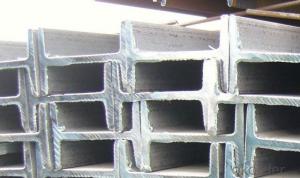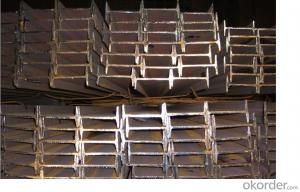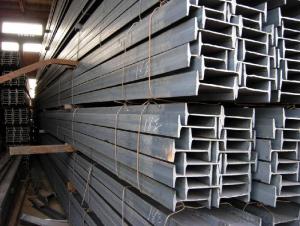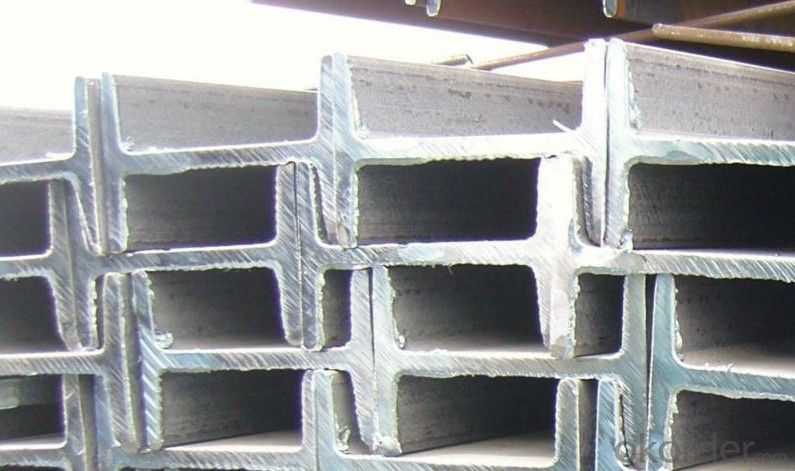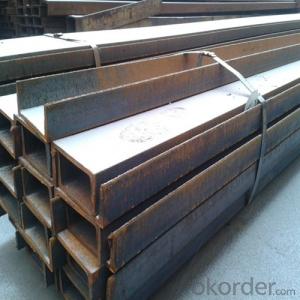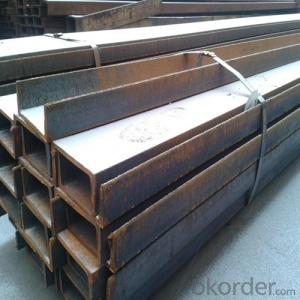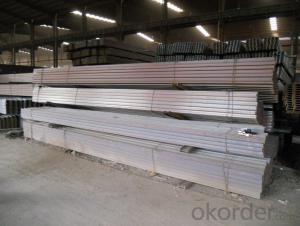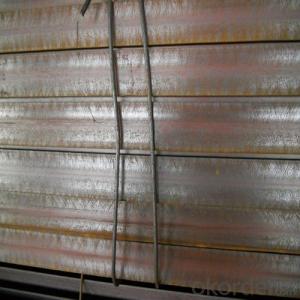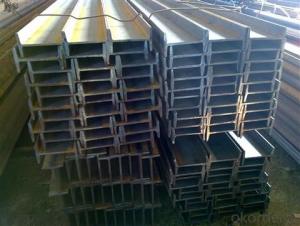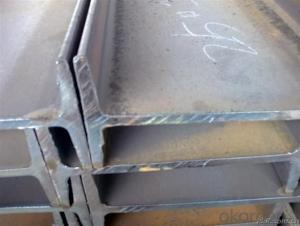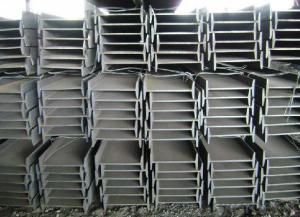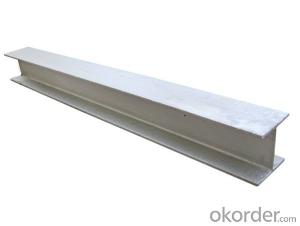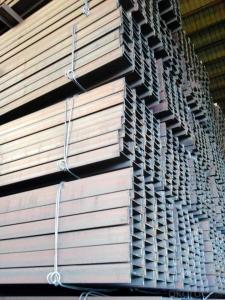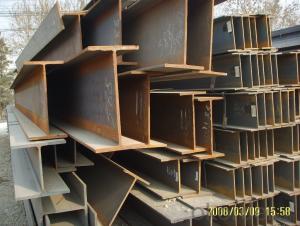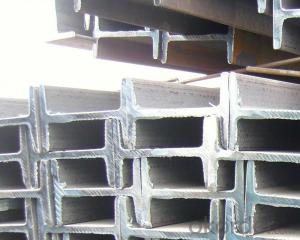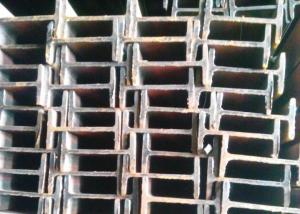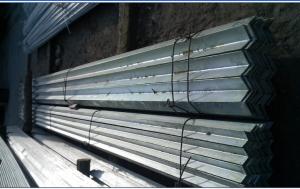Hot Rolled Steel I-Beams Q235, A36 for Construction
- Loading Port:
- China main port
- Payment Terms:
- TT or LC
- Min Order Qty:
- 25000 m.t.
- Supply Capability:
- 200000 m.t./month
OKorder Service Pledge
OKorder Financial Service
You Might Also Like
Product Description:
Specifications of Hot Rolled Steel I-Beams Q235, A36 for Construction:
1. Invoicing on theoretical weight or actual weight as customer request
2. Length: 5.8m, 6m, 9m, 12m as following table
3. Sizes of Steel I-Beams: 80mm-270mm
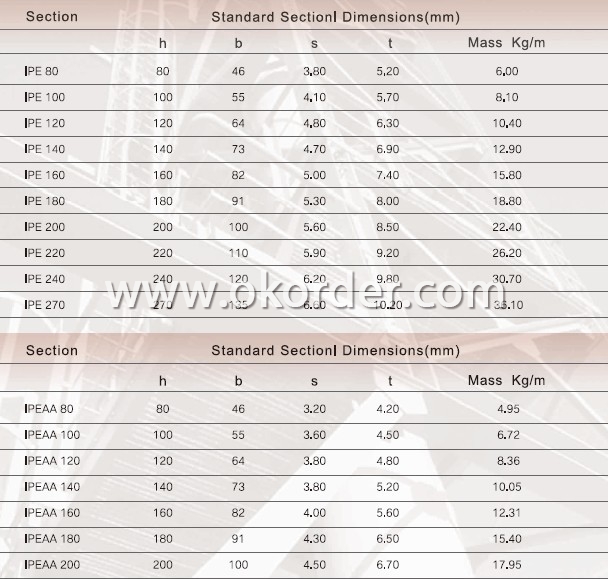
Dimensional Specifications of Steel I-Beams: EN10025, ASTM, GB Standard, JIS, etc.
Material Specifications of Steel I-Beams: EN10025, S235JR, GB Q235B or Equivalent
Applications of Hot Rolled Steel I-Beams Q235, A36 for Construction:
Commercial building structure
Pre-engineered buildings
Machinery support structures
Prefabricated structure
Medium scale bridges
Package & Delivery of Hot Rolled Steel I-Beams Q235, A36 for Construction
1.Package: All the products are packed in bundles and tied by steel wire rod then put into containers or in bulk cargo. Each bundle of I-Beam will be hung with the markings of CNBM or as the requriements of the customer. Each bundle contains about 50 pieces.
2.Tag mark: there will be tag mark tied up on the bundles. The information usually including supplier logo and name, product name, made in China, shipping marks and other information request by the customer.
If loading by container the marking is not needed, but we will prepare it as customer request.
3. Delivery: The Steel I-Beams will be delivered to the loading port in 45 days after receiving your advance payment or the original L/C at sight.
Transportation: the goods are delivered by truck from mill to loading port, the maximum quantity can be loaded is around 40MTs by each truck. If the order quantity cannot reach the full truck loaded, the transportation cost per ton will be little higher than full load.
FAQ:
Q1: Why buy Materials & Equipment from OKorder.com?
A1: All products offered byOKorder.com are carefully selected from China's most reliable manufacturing enterprises. Through its ISO certifications, OKorder.com adheres to the highest standards and a commitment to supply chain safety and customer satisfaction.
Q2: How do we guarantee the quality of our products?
A2: We have established an advanced quality management system which conducts strict quality tests at every step, from raw materials to the final product. At the same time, we provide extensive follow-up service assurances as required.
Q3: How soon can we receive the product after purchase?
A3: Within three days of placing an order, we will begin production. The specific shipping date is dependent upon international and government factors, but is typically 7 to 10 workdays.
Images:
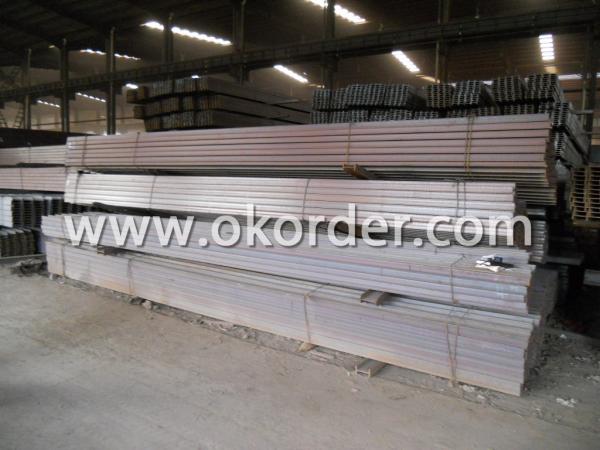
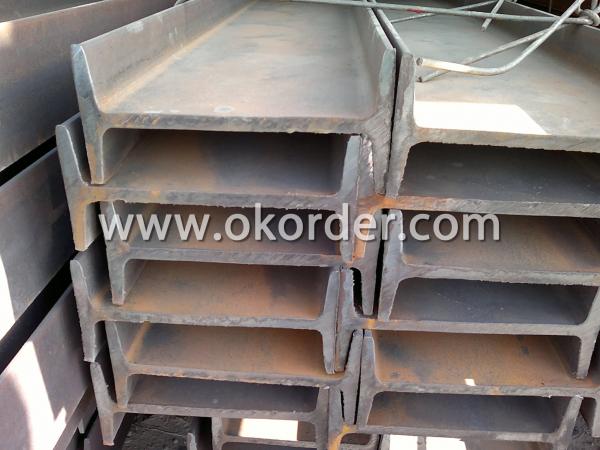
- Q: Are steel I-beams recyclable?
- Indeed, steel I-beams can be recycled. Thanks to its durability and high scrap value, steel is widely considered one of the most recycled materials globally. Once steel I-beams reach the end of their useful lifespan, they can undergo recycling and be transformed into new steel products. The recycling procedure consists of melting down the steel to eliminate any impurities, after which it is fashioned into new I-beams or other steel products. By recycling steel I-beams, not only are we conserving natural resources, but we are also reducing the energy consumption and carbon emissions linked to the production of new steel from raw materials.
- Q: How do steel I-beams handle vibrations?
- The inherent structural properties of steel I-beams make them highly effective in managing vibrations. The flanges and web of an I-beam contribute to its stiffness and rigidity, allowing it to distribute loads, resist bending, twisting, and deformations caused by vibrations efficiently. The vertical support provided by the web and the horizontal beams formed by the flanges work together to resist bending and enhance the strength of the I-beam. This well-designed structure enables the I-beam to transfer loads and vibrations effectively along its entire length, minimizing the risk of structural failure or damage. Steel itself possesses remarkable strength and durability, which aids in absorbing and dissipating vibrations. Unlike other materials, steel is less prone to resonance, meaning it does not readily vibrate at its natural frequency. This characteristic prevents the amplification of vibrations and reduces the possibility of fatigue failure. Furthermore, the weight and mass of steel I-beams play a significant role in their ability to handle vibrations. The substantial weight of the beams helps dampen and absorb vibrations, preventing their propagation throughout the structure. This quality makes steel I-beams particularly suitable for applications in which vibrations are a concern, such as in bridges, high-rise buildings, and industrial structures. In conclusion, steel I-beams are meticulously designed and engineered to effectively manage vibrations. Their shape, material properties, and weight make them a dependable choice for structural applications where vibration control and stability are of utmost importance.
- Q: Can steel I-beams be used in curved or arched structures?
- No, steel I-beams are not typically used in curved or arched structures as their shape is not conducive to bending or curving. Other types of structural elements, such as curved steel beams or trusses, are typically used for such applications.
- Q: Can steel I-beams be used in industrial facilities?
- Yes, steel I-beams are commonly used in industrial facilities for their strength, durability, and load-bearing capabilities. They provide structural support for overhead cranes, mezzanines, platforms, and heavy equipment, making them a reliable choice for industrial construction.
- Q: How do steel I-beams perform in terms of fire safety?
- Steel I-beams are highly regarded for their excellent performance in terms of fire safety. The inherent properties of steel make I-beams highly resistant to fire, making them a preferred choice in structural applications where fire safety is a concern. Firstly, steel has a high melting point, typically around 2,500 degrees Fahrenheit (1,370 degrees Celsius). This means that in the event of a fire, steel I-beams can withstand high temperatures for an extended period without losing their structural integrity. Unlike materials like timber or concrete, which can weaken or even collapse under extreme heat, steel maintains its strength and load-bearing capacity. Additionally, steel I-beams have a low flammability, meaning they do not easily catch fire or contribute to the spread of flames. Steel is not a combustible material, and it does not release toxic gases or smoke when exposed to fire. This characteristic is crucial in preventing the rapid spread of fire in a building, giving occupants more time to evacuate safely. Furthermore, steel I-beams have a high thermal conductivity, which allows them to dissipate heat quickly. This property helps prevent localized areas of extreme heat, reducing the risk of structural failure. It also aids in the rapid cooling of the steel after the fire is extinguished, minimizing the potential for post-fire damage. However, it is important to note that while steel I-beams possess excellent fire-resistant properties, they can still be affected by prolonged exposure to high temperatures. Over time, the excessive heat can cause the steel to lose its strength and structural integrity. Therefore, it is necessary to employ fire protection measures such as fire-resistant coatings or fireproof insulation to further enhance the fire safety performance of steel I-beams. In conclusion, steel I-beams perform exceptionally well in terms of fire safety. Their high melting point, low flammability, and ability to dissipate heat efficiently make them a reliable choice in structural applications where fire safety is a priority. However, it is crucial to implement additional fire protection measures to ensure optimal fire resistance and to comply with local building codes and regulations.
- Q: What are the different types of connections for steel I-beams?
- There are several different types of connections that can be used for steel I-beams, depending on the specific application and structural requirements. Some of the most common types of connections for steel I-beams include: 1. Welded Connections: Welding is a widely used method for connecting steel I-beams. In this type of connection, the flanges and web of the I-beam are welded directly to the adjacent members or plates, providing a strong and rigid connection. 2. Bolted Connections: Bolted connections involve using bolts, nuts, and washers to connect the I-beams to other members or plates. This type of connection allows for easier assembly and disassembly, making it suitable for applications where flexibility is required. 3. Riveted Connections: Riveting is an older method of connecting steel I-beams but is still used in certain applications. In this type of connection, rivets are used to join the I-beams together, providing a secure and durable connection. 4. Moment Connections: Moment connections are designed to resist rotational forces and provide stability to the overall structure. These connections are more complex and involve welding or bolting additional plates and angles to the I-beams to increase their strength and rigidity. 5. Shear Connections: Shear connections are designed to transfer shear forces between the I-beams and other members. These connections typically involve using bolts or welds to connect the flanges or webs of the I-beams to adjacent members or plates. 6. Composite Connections: Composite connections involve combining steel I-beams with other materials, such as concrete or timber, to create a stronger and more efficient structural system. These connections typically involve using bolts, welds, or specialized connectors to join the different materials together. It is important to note that the choice of connection type depends on factors such as the load requirements, design specifications, and the type of structure being built. Consulting with a structural engineer or expert is recommended to determine the most appropriate connection type for a specific application.
- Q: Are steel I-beams suitable for both residential and commercial construction?
- Yes, steel I-beams are suitable for both residential and commercial construction. Their strong and durable nature makes them ideal for supporting heavy loads and providing structural integrity in various building types. Additionally, steel I-beams offer versatility, as they can be customized to meet specific design requirements and are available in a range of sizes and shapes.
- Q: Can steel I-beams be used for overhead garage doors?
- No, steel I-beams cannot be used for overhead garage doors as they are not designed to support the weight and movement of the door. Instead, specialized tracks and torsion springs are used to ensure smooth and safe operation.
- Q: How do steel I-beams contribute to the overall durability and longevity of a structure?
- Steel I-beams contribute to the overall durability and longevity of a structure due to their high strength-to-weight ratio and resistance to bending and deflection. These beams provide structural support by distributing the weight of the load evenly, minimizing the risk of structural failure and collapse. Additionally, their ability to withstand extreme weather conditions, corrosion, and fire makes them highly durable, ensuring the longevity of the structure.
- Q: Can steel I-beams be used in entertainment or stadium construction?
- Yes, steel I-beams can be used in entertainment or stadium construction. Steel I-beams are commonly used in construction due to their strength and durability. They provide excellent load-bearing support, making them suitable for large-scale structures like stadiums or entertainment venues where there is a need for substantial structural support. Steel I-beams can withstand heavy loads and are often used to create the framework for seating areas, roofs, and other crucial components of these types of structures. Additionally, steel I-beams can be easily customized and fabricated to meet specific design requirements, allowing for flexibility in the construction process. Overall, the use of steel I-beams in entertainment or stadium construction ensures the safety and stability of the structure while allowing for large open spaces and expansive seating arrangements.
Send your message to us
Hot Rolled Steel I-Beams Q235, A36 for Construction
- Loading Port:
- China main port
- Payment Terms:
- TT or LC
- Min Order Qty:
- 25000 m.t.
- Supply Capability:
- 200000 m.t./month
OKorder Service Pledge
OKorder Financial Service
Similar products
Hot products
Hot Searches
Related keywords
